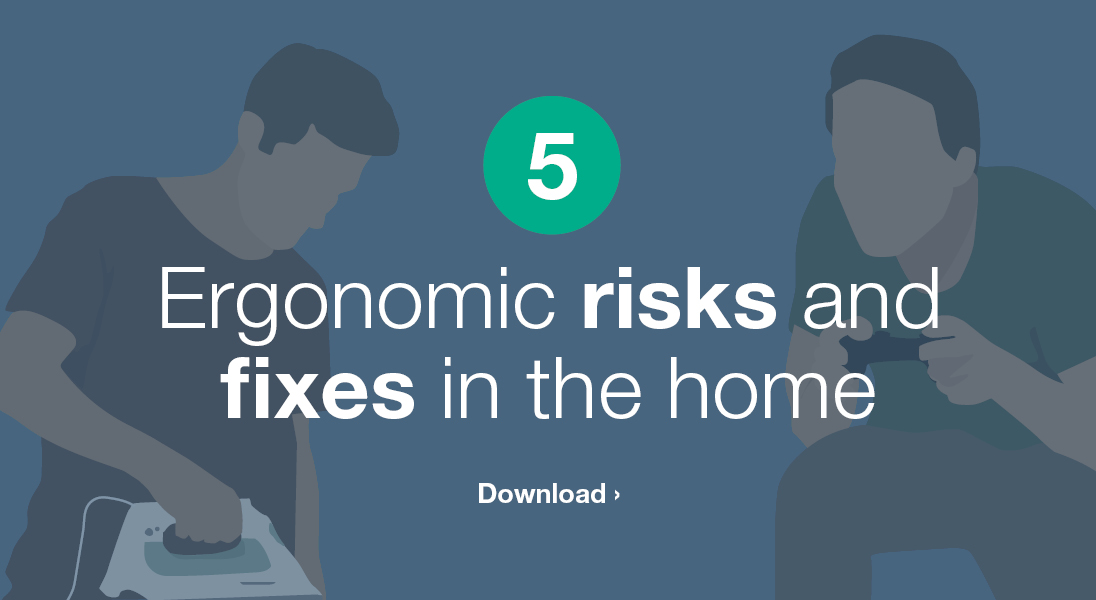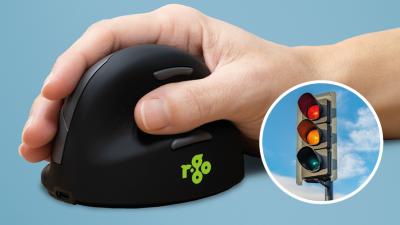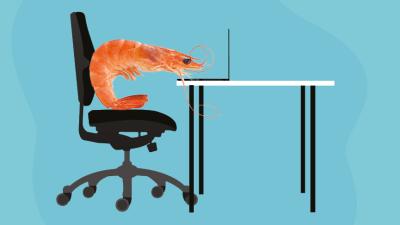We're a nation of screen-addicted couch potatoes (according to one study), with the average Brit spending more time using tech than sleeping.
This post is all about how to protect your health while you’re working, playing, or relaxing at home - but we know you're busy so we've also produced an infographic with an overview of the same tips.
1. Gaming
Immersive games encourage you to sit for hours on end - often hunched forward staring intently at the screen making the same repetitive movements with your thumbs. Over time this can lead to:
- Dry/sore eyes
- Blurred vision
- Headaches
- Neck, shoulder and back pain
- Carpal tunnel
- Repetitive strain syndrome (RSI)
- Tendonitis
Fixes
Invest in a good ergonomic chair
In order to get the right support from your chair, you need to be able to adjust features like seat depth and height, lumbar support and sitting angle.
Lean back, not forward
Studies show that reclining is better than hunching if you want to prevent back pain.
Experiment with TV/computer height
Raising or lowering your screen a few inches could dramatically improve your comfort.
Set an alarm every 30 mins to move
This will remind you to change position and give your eyes a blinking break away from the screen.
Pause every hour for a hydration break
Take a few minutes to move, stretch, jump about, or grab yourself a drink of water.
2. Laptops, phones and tablets
The problem with portable tech is that it’s small. How often do you find yourself looking down towards our hands to use your phone? This head-hanging posture can put a remarkable amount of strain on your spine and other areas of the body. Look out for:
- Tech neck
- Lower back pain
- Forearm pain
- Pain in hands, fingers and wrists
- RSI
- Dry/sore eyes
- Sleep deprivation.
Fixes
Use a stand, keyboard and mouse with laptop
We can provide you with a laptop pack that contains everything you need to set up a portable ergonomic workstation.
Use a tablet stand
Propping your tablet up to eye level instantly reduces your risk of discomfort and pain - perfect for browsing recipes and watching videos.
Ban technology 1 hour before bed
Some studies show a link between technology use and sleep deprivation. Use the hour before bed to wind down without technology.
Use a blue light filter
Use a blue light filter screen protector to limit the amount of damaging blue light received by your eyes.
Limit usage to a few hours a day
Portable technology should only be used sporadically when you don’t have access to an ergonomic desk set-up. Remember to move!
3. Desktop computer
Sitting at a poorly set-up workstation for long periods of time can encourage you to have bad posture habits such as hunching and slumping. It can also be damaging for your eyes. Risks include:
- Lower back injuries
- Discomfort to neck and shoulders
- Pain in popliteal arch (underside of knee and thigh)
- Carpal tunnel
- Headaches
- Eye dryness, soreness and blurring.
Fixes
Raise screen to eye level
Adjustable monitor arms are great for this as you can quickly adjust to the perfect height while freeing up desk space.
Get an ergonomic chair
Ideally, find a chair with adjustable back, seat, height and lumbar support.
Have a DSE assessment
Our assessors visit people at home as well as the office. They offer pointers and can recommend suitable equipment.
Try a vertical mouse
A vertical mouse, like the Penguin, places the arm in a neutral position for better comfort and protection from musculoskeletal disorders caused by twisting.
Use a compact keyboard to reduce stretching
The movements you make between your keyboard and mouse mount up over time and can cause discomfort and injury. A compact keyboard knocks off the number pad, although you can get detachable number pads for data input. Browse and shop our range of keyboards ›
4. Cooking and ironing
Believe it or not, gentle housework can be a health hazard. While it pays to be careful, this often doesn’t sit well as an excuse not to do it (sadly). Risks include:
- Foot discomfort from prolonged standing
- Back pain from hunching over (especially if tall)
- Knee pain
- Injury from heavy lifting.
Fixes
Stand on an anti-fatigue mat
Place a DeskRite Anti-Fatigue Mat under your feet while you iron or bake to provide exquisitely comfortable cushioning.
Use a leg rest
Placing a leg rest in your kitchen gives you the option to rest either leg if you start to get tired while standing for long periods of time.
Break up with periods of rest
Make sure you take a break every hour or so - throw yourself down on the sofa or even have a quick lie-down on the bed. It’ll take the weight off your musculoskeletal system.
Break up with stretches
Do some gentle stretches to wake up your muscles and relieve any stiffness.
Comfortable height setting on ironing board
Stand upright with your arm holding the iron positioned at a ninety degree angle from your body.
5. Watching TV
According to Ofcom, the average Brit spends four hours every day watching TV. After a long day at work a series binge can feel like an appealing way to switch off and wind down - but it's not always the healthiest option and risks can include:
- Back pain
- Impaired digestion
- Eye issues
- Knee and leg discomfort.
Fixes
Frequently change position
We all love a big squishy sofa but this lack of support can cause issues if you plan to spend the entire evening on it. To combat pain and discomfort from long-term sofa sitting, make sure you change position frequently (reclining is better than slumping).
Use posture supports
Use cushions to help support your spine's natural curve, or buy a back support, which is designed to encourage a healthier position for the spine. This gives lateral as well as lumbar support to aid pain relief by correct alignment of the spine, pelvis and legs.
Take breaks to more around
It's important to take moving breaks whenever you plan on sitting for a long time. Use ad breaks to remind you to move. Get up, have a jump around, make a cup of tea or have a toilet break to get the oxygen moving through your body.
Stretch
There's nothing like a good stretch to get you out of a bad posture. You could even do some simply sitting stretches to activate your muscles and relieve pressure. Here are some stretch ideas to start with.
Limit the amount of time spent watching TV
The most obvious remedy is to stop watching TV. Go for a walk or a jog instead; eat dinner at your dining room table; spread your favourite series out over a number of months instead of watching it all at once. In the end, the best way of fighting DSE health risks is to reduce the amount of time you spend using screens every day. It may take a conscious effort to wean yourself off your favourite devices, but if it saves your back, your sight and your long term health, isn't it worth it?












